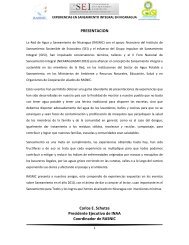Open Planning of Sanitation Systems
Open Planning of Sanitation Systems
Open Planning of Sanitation Systems
Create successful ePaper yourself
Turn your PDF publications into a flip-book with our unique Google optimized e-Paper software.
Elisabeth Kvarnström and Ebba af Petersens<strong>of</strong> PHAST ensures that hygiene behaviour receives due attention. The workshop facilitatorshould, <strong>of</strong> course, be experienced in PHAST and LFA methodologies, and also be familiarwith the links between sanitation and agriculture and aquaculture, and above all, have a verygood understanding <strong>of</strong> the community situation.CASE STUDY: Problem identificationThe problem in Vadsbro was a poorly functioning wastewater treatment plant that neededupgrading in order to meet the wastewater discharge standards set by the local municipality. Theproject was initiated after some student reports from a nearby school had shown that alternativesto building a new treatment plant in the village existed.BOX 2: Participatory methods and sanitation planningThe survey <strong>of</strong> planning and implementation tools (Appendix 2) clearly indicated the needfor planning processes to facilitate the participation <strong>of</strong> future users <strong>of</strong> the systems and otherstakeholders to ensure project success. One-sided promotion <strong>of</strong> a single sanitation technologymay lead to a lack <strong>of</strong> project ownership and suspicion among future users that they are not<strong>of</strong>fered the best solution for their needs. Consequently, users will not be motivated to understandand use the proposed system correctly.The importance <strong>of</strong> participatory planning was also expressed by the survey respondents(Appendix 3). As one respondent expressed it: “to arrive in a community with the idea <strong>of</strong>implementing ecosan before consulting the community is making a mockery <strong>of</strong> participatoryapproaches and the project is probable to fail”. The respondents had a favourable opinion<strong>of</strong> PHAST, or, in a wider sense, the SARAR method, which several had used to facilitateparticipatory project planning. This approach would also be in accordance with the householdcentredenvironmental sanitation approach (HCES) as advocated by Schertenleib et al. (2004),where the household is the focal point <strong>of</strong> planning. According to Schertenleib et al. (2004) onlyproblems not manageable at the household level should be ‘exported’ to a larger jurisdiction, e.g.,neighbourhood, town or city.Stakeholder identificationThe stakeholder groups and their roles need to be identified. The stakeholders themselves or,for large communities, their representatives should be involved in the planning process earlyon. In sanitation planning, stakeholders may include:• Residents – users and <strong>of</strong>ten owners <strong>of</strong> the planned sanitation system• Planners and political decision makers – for example, municipal planning andenvironmental authorities• Schools and commercial operations• Land owners – owners <strong>of</strong> the land where components <strong>of</strong> the sanitation system will belocated• Contractors – they may be involved in the construction and/or operation and maintenance<strong>of</strong> the system• Farmers – users <strong>of</strong> treated waste products and, possibly, reclaimed water• Community-based organizations• Other stakeholders, such as neighbours with freshwater wells, people living downstream,etc.4



![Project Document [PDF: 2.31 MB] - EcoSanRes](https://img.yumpu.com/51279385/1/184x260/project-document-pdf-231-mb-ecosanres.jpg?quality=85)












![Latrines à compost [high-resolution colour PDF: 12.3MB] - EcoSanRes](https://img.yumpu.com/31726141/1/185x260/latrines-a-compost-high-resolution-colour-pdf-123mb-ecosanres.jpg?quality=85)